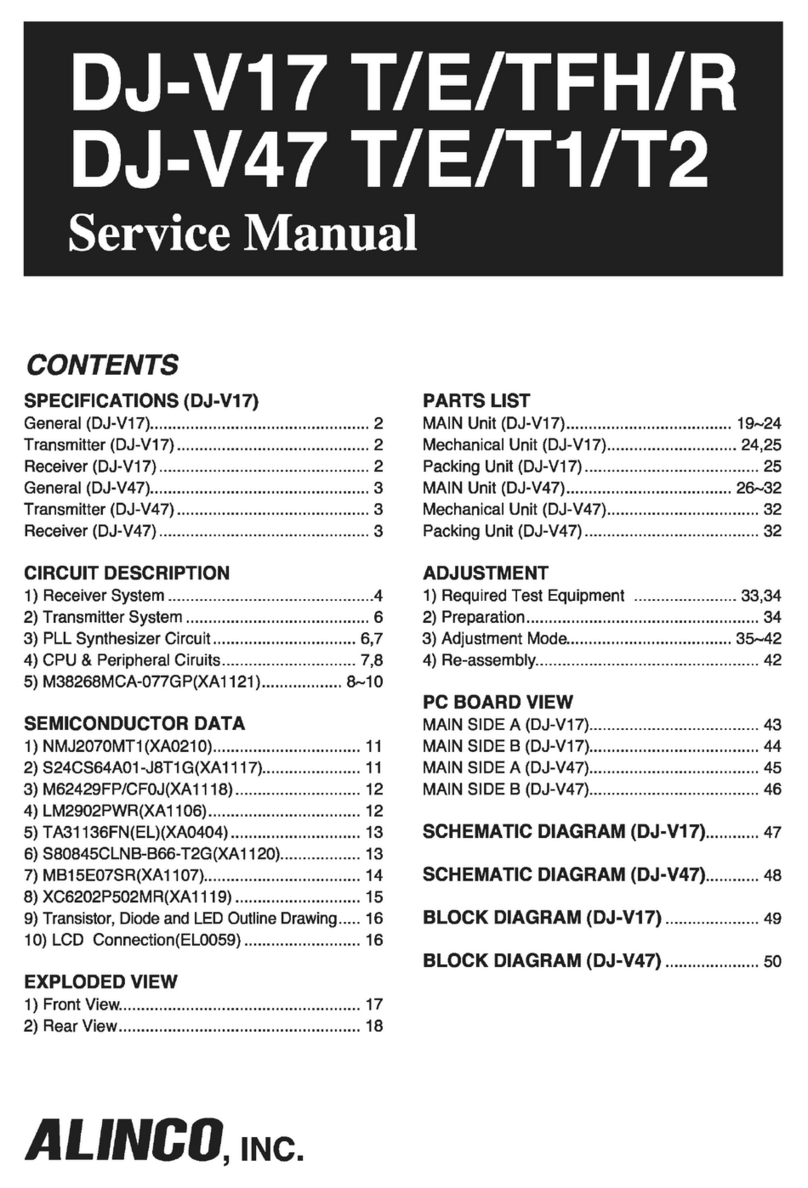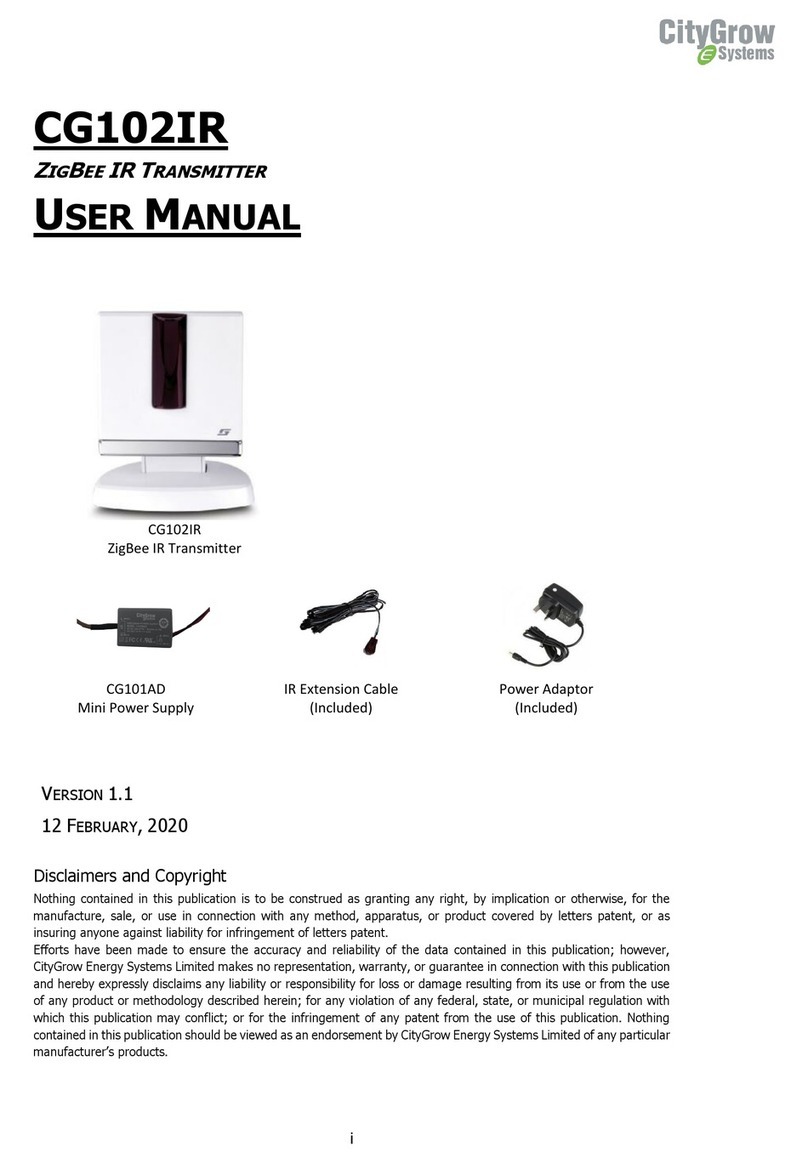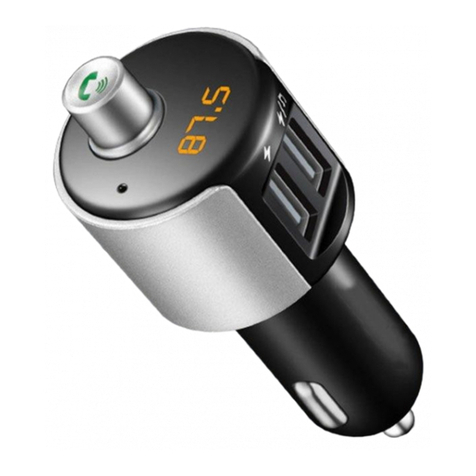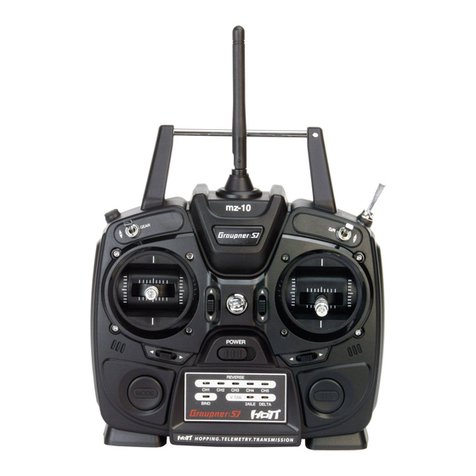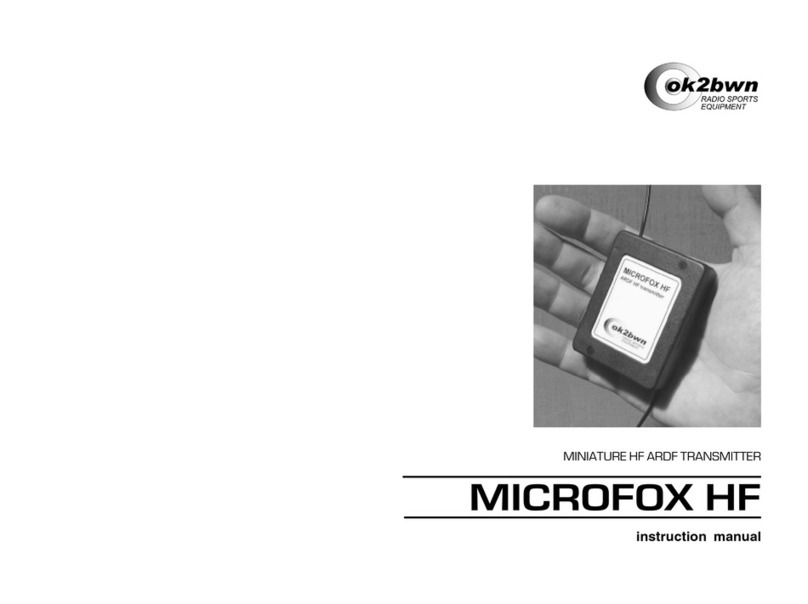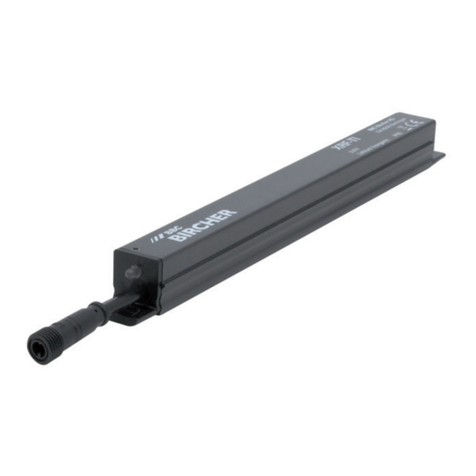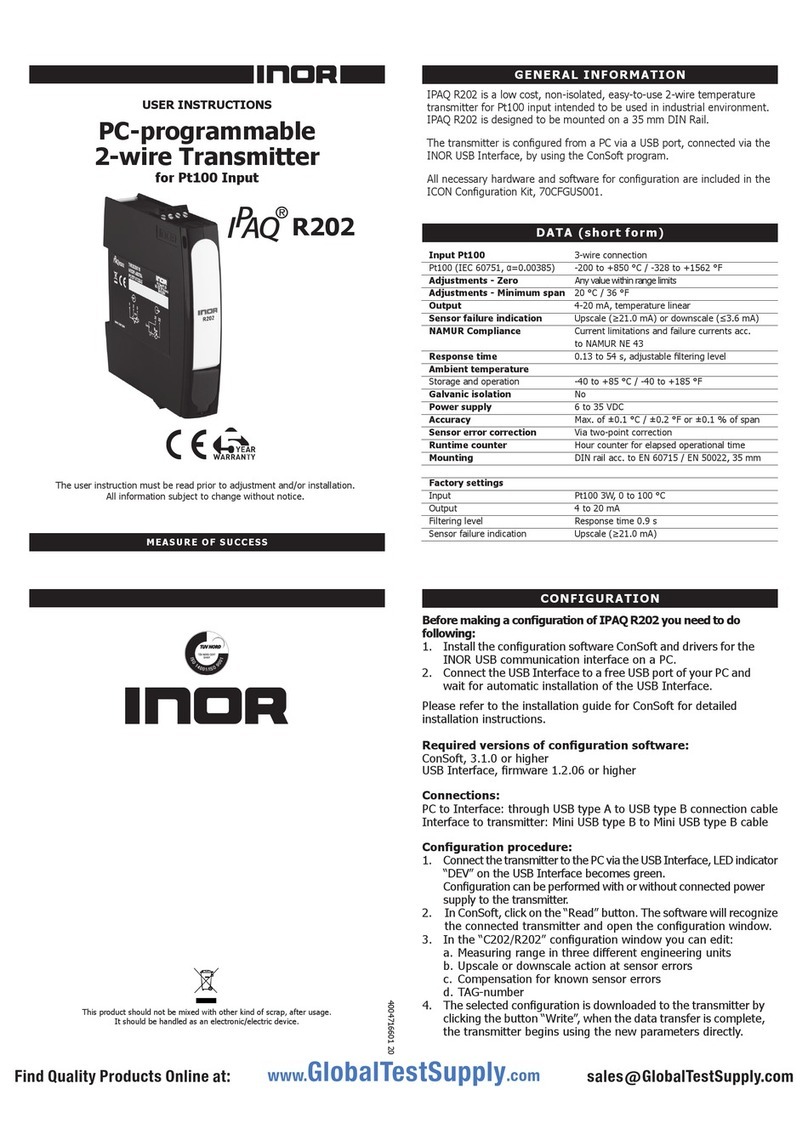Wavetek 3ST User manual

WavetekWavetek
WavetekWavetek
Wavetek
CATV Division
5808 Churchman Bypass
Indianapolis, IN 46203-6109
(800)851-1198
(317)788-5960
Fax: (317)782-4607
E-Mail: [email protected]
Internet: http://www.wavetek.com
11/96 Rev. I,
Manual Part No.
6510-00-0273
This document contains information proprietary to
Wavetek. The information in this document
is not to be used or duplicated in any manner without
the prior approval, in writing, of Wavetek.
OPERATION MANUAL
MODEL 3ST
SYSTEM SWEEP TRANSMITTER

WARRANTY
Wavetek warrants that all Products manufactured or procured by Wavetek conform to
Wavetek’s published specifications and are free from defects in materials and workmanship
for a period of one (1) year from the date of delivery to the original Buyer, when used under
normaloperatingconditionsand withintheserviceconditionsforwhichtheyweredesigned.
This warranty is not transferrable and does not apply to used or demonstration products.
The obligation of Wavetek arising from a Warranty claim shall be limited to repairing, or at
its option, replacing without charge, any assembly or component (except batteries) which in
Wavetek’s sole opinion proves to be defective within the scope of the Warranty. In the event
Wavetekisnotabletomodify,repairorreplacenonconformingdefectivepartsorcomponents
toa condition aswarrantedwithin a reasonabletimeafter receipt thereof,Buyersshall receive
credit in the amount of the original invoiced price of the product.
Wavetek must be notified in writing of the defect or nonconformity within the Warranty
period and the affected Product returned to Wavetek’s factory, designated Service Provider,
or Authorized Service Center within thirty (30) days after discovery of such defect or
nonconformity. Buyer shall prepay shipping charges and insurance for Products returned to
Wavetek or its designated Service Provider for warranty service. Wavetek or its designated
Service Provider shall pay costs for return of Products to Buyer.
Wavetek shall have no responsibility for any defect or damage caused by improper storage,
improperinstallation,unauthorized modification, misuse, neglect, inadequate maintenance,
accidentor for any Product which has been repairedor altered by anyone other than Wavetek
or its authorized representative or not in accordance with instructions furnished by Wavetek.
The Warranty described above is Buyer’s sole and exclusive remedy and no other warranty,
whether written or oral, expressed or implied by statute or course of dealing shall apply.
Wavetek specifically disclaims the implied warranties of merchantability and fitness for a
particular purpose. No statement, representation, agreement, or understanding, oral or
written,madebyan agent, distributor, or employee of Wavetek, which is not contained in the
foregoing Warranty will be binding upon Wavetek, unless made in writing and executed by
anauthorized representativeof Wavetek.Undernocircumstancesshall Wavetekbe liablefor
any direct, indirect, special, incidental, or consequential damages, expenses, or losses,
including loss of profits, based on contract, tort, or any other legal theory.
Extended Warranty Programs
Extended warranties and service contracts are available for new and currently owned
equipment for an additional cost. Contact the Customer Service Department (800 851-
1198) for details pertaining to extended warranties and service contracts.
Return Authorization Procedure
The customer MUST obtain a RETURN AUTHORIZATION NUMBER from the
Customer Service Department (800 851-1198) prior to returning any equipment for
warranty or non-warranty repair. Wavetek accepts no liability for any instrument or
subassembly returned to the factory without this number. Any correspondence regarding
returned instruments or subassemblies should be referenced to that number.

Contents
SECTION 1 - GENERAL INFORMATION
1.1 INTRODUCTION ................................................................ 1-1
1.2 SPECIFICATIONS ............................................................. 1-2
1.2.1 Frequency .................................................................... 1-2
1.2.2 Level Measurement ................................................... 1-2
1.2.3 Hum Measurement..................................................... 1-2
1.2.4 Carrier to Noise Measurement .................................. 1-3
1.2.5 Telemetry .................................................................... 1-3
1.2.6 Transmitter.................................................................. 1-4
1.2.7 Spectrum Mode........................................................... 1-4
1.2.8 Intermodulation Distortion ........................................ 1-4
1.2.9 Depth of Modulation .................................................. 1-5
1.2.10 Serial Interface .......................................................... 1-5
1.2.11 General....................................................................... 1-5
1.2.12 Powering .................................................................... 1-5
1.2.13 Standard Accessories................................................. 1-6
1.2.14 Options....................................................................... 1-6
1.2.15 Optional Accessories................................................. 1-6
SECTION 2 - INSTALLATION
2.1 INTRODUCTION ............................................................... 2-1
2.2 UNPACKING AND INSPECTION ................................... 2-1
2.3 INSTALLATION .................................................................. 2-1
2.4 WARRANTY INFORMATION .......................................... 2-2
2.5 POWER REQUIREMENTS ............................................... 2-3
2.6 CABLE SPECIFICATIONS ................................................ 2-3
2.7 TECHNICAL SUPPORT .................................................... 2-5

2.8 WORLDWIDE SALES OFFICES .....................................2-5
SECTION 3 - USER INTERFACE
3.1 INTRODUCTION .............................................................. 3-1
3.2 FRONT-PANEL DESCRIPTION ................................... 3-1
3.2.1 Soft Keys ...................................................................... 3-1
3.2.2 Measurement Mode Selection Keys ......................... 3-2
3.2.3 Support Mode Selection Keys ................................... 3-4
3.2.4 Arrow Keys .................................................................. 3-4
3.2.5 Alpha-Numeric Entry Keys ....................................... 3-5
3.2.6 Printing ........................................................................ 3-6
SECTION 4 - OPERATION - HOW TO USE THE 3ST
TRANSMITTER
4.1 INTRODUCTION ............................................................. 4-1
4.2 STEALTH SWEEP START-UP PROCEDURE ......... 4-1
4.3 SETUP.................................................................................. 4-4
4.3.1 General Setup............................................................. 4-5
4.3.2 Measurement Setup................................................... 4-8
4.3.3 How To Setup Your Channel Plan ..........................4-10
4.3.4 How To Edit Channel Parameters .......................... 4-12
4.3.5 Sweep Transmitter ....................................................4-20
4.4 HOW TO PERFORM LEVEL MEASUREMENTS.... 4-22
4.5 HOW TO MEASURE TILT-BALANCING AN
AMPLIFIER ........................................................................4-24
4.6 SCAN MODE ...................................................................... 4-26
4.7 HOW TO MEASURE C/N ................................................ 4-30
4.8 HOW TO MEASURE HUM ............................................. 4-32
4.9 MODULATION ................................................................. 4-33

4.10 SPECTRUM ANALYZER MODE ................................ 4-34
4.11 SWEEP MODE ................................................................. 4-39
4.12 FILE.................................................................................... 4-40
4.12.1 How to Store/View/Delete Measurement Files ...4-40
4.13 AUTO ................................................................................. 4-42
4.13.1 How to Create/Edit/Delete Test Locations ......... 4-42
4.13.2 How to Perform an Auto Test ................................ 4-45
4.13.3 Viewing/Printing Auto Test Files ..........................4-53
4.14 STATUS ............................................................................. 4-59
SECTION 5 - REVERSE SWEEP OPTION
5.1 INTRODUCTION ............................................................. 5-1
5.1.1 Wavetek Stealth Reverse Sweep Concept .............. 5-1
5.1.2 Basic Reverse Sweep Procedure .............................. 5-1
5.1.3 Interfacing With Different Network Architectures 5-2
5.2 HOW TO SETUP FOR REVERSE SWEEPING ......... 5-5
5.2.1 Enable or Disable Reverse Sweep ...........................5-5
5.2.2 Select the Frequency of the Reverse Telemetry
Carrier ......................................................................... 5-6
5.2.3 Access Reverse Sweep Plans .................................... 5-6
5.2.4 Selecting a Reverse Sweep Plan .............................. 5-6
5.2.5 Creating a New Reverse Sweep Plan ...................... 5-7
5.2.6 Editing a Reverse Sweep Plan ................................. 5-10
APPENDIX A: STATUS INDICATORS ............................... A-1
APPENDIX B: USER MESSAGES ......................................... B-1

1-1
SECTION1GENERALINFORMATION
1.1 INTRODUCTION
The Wavetek Sweep System Transmitter performs essential cable TV
system preventive maintenance tests with accuracy and ease. Signal
levels, hum, C/N, and frequency response can be quickly tested
without subscriber interference.
The Sweep System is made up of two components; the Sweep System
Receiver 3SR, and Sweep System Transmitter 3ST. The contents of
this manual will describe the care and operation of the Sweep System
Transmitter 3ST, including Reverse Sweep operation.
Sweep response is tested by injecting a low level signal in vacant
spectrum areas, and monitoring cable system carrier levels in occupied
spectrum areas. In addition to generating the sweep test signal, the
Transmitter 3ST continuously monitors the system carriers. The 3ST
sends headend level readings to the 3SR Receiver with every sweep
update. In this way, any headend level changes are compensated by
the receiver to maintain the utmost measurement accuracy.
Sweep response measurements won't be affected by signal levels
changing in the headend. The Transmitter 3ST has all of the mea-
surement capability of the 3SR Receiver, so the Headend Technician
can keep an eye on headend levels.
With the Reverse Sweep option, a transmitter is built into the hand-
held sweep receiver. The headend sweep transmitter (3ST) is set up
to receive the reverse sweep sent from the field. When a reverse
sweep is activated from a field test point, the headend transmitter
receives the telemetry signal that indicates which receiver is sending
the sweep. The headend transmitter measures the sweep, and sends
the results, along with the serial number of the sending receiver via its
telemetry signal to the field. The field receiver with the tagged serial
number then displays the sweep response as measured in the headend
on its LCD.
MODEL 3ST

1-2
The 3ST Transmitter is a full-featured signal analysis meter, with a
complete spectrum display and an analog representation of single
channel measurement data. When tuned to a specific channel, a
comprehensive set of information is provided: tuned channel, video
frequency and level, audio frequency and level, the difference
between video and audio carrier levels.
The 3ST Transmitter is a standard 19" rack mount unit, that weighs
approximately fifteen pounds. Its 320 X 240 dot matrix LCD shows
measurement data in both graphical and numerical form.
1.2 SPECIFICATIONS
1.2.1 Frequency
Range: 5 to 1,000 MHz
Accuracy: + 10 ppm at 25°C; + 10 ppm drift over
temp.; + 3 ppm/year aging
Resolution Bandwidths: 30, 280 kHz (30 kHz for CSO)/CTB only)
Tuning Resolution: 10 kHz
Sweep Resolution: 250 kHz maximum
1.2.2 Level Measurement
Range: -40 to +60 dBmV
Resolution: 0.1 dB
Accuracy: + 1.0 dB from 0 to + 40°C (typical),
(relative to 25°C)
1.2.3 Hum Measurement
(carrier > 0 dBmV) Non-scrambled channels only
Range: 0 to 10%

1-3
Resolution: <0.2%
Accuracy: +0.7%
1.2.4 Carrier to Noise Measurement
Non-scrambled channels only. No preselection required for 78
channels at +10 dBmV input level.
Carrier to Noise Ratio
Depth of Measurement Characteristics
Video Carrier Level (dBmV)
Carrier to Noise Range
0
10
20
30
40
50
60
-10 0 10 14 24
*Specified results with the measurement offset within 2 to 3 MHz
range above the video carrier.”
Resolution: 0.5 dB
Range 52 dB maximum
1.2.5 Telemetry
Frequency: User defined, 5 to 1,000 MHz
Modulation: FSK, 100 kHz deviation
Spectrum Required: »1 MHz recommended
*
+3.0 dB Accuracy
+2.0 dB Accuracy
Out of Measurement Range

1-4
1.2.6 Transmitter
Frequency Range: 5 to 1,000 MHz
Level Range: +20 to +50 dBmV (1) ; settable in 2 dB
increments
Spectral Purity: Hars -30 dBc; Spurs -35 dBc
1.2.7 Spectrum Mode
Spans: 3, 5, 10, 20, and 50 MHz (0.3, 0.5, 1, 2, and
5 MHz/div)
Sweep Rates: 2 seconds (50 & 5 MHz)
Display Scaling
and Range: 0.5, 1, 2, 5, and 10 dB/division; 6 vertical
divisions
Spurious Free
Dynamic Range: 60 dB (typical specifications)
1.2.8 Intermodulation Distortion
CSO / CTB Characteristics
Video Signal Level (dBmV)
Depth of Measurement (dB)
(without preamplification / with
preselection)
0
10
20
30
40
50
60
-20 -10 0 10 20 30
*
Out of Measurement Range
+3.0 dB Accuracy
+2.5 dB Accuracy

1-5
*Typical Specifications
Range: 60 dB maximum
Resolution: 1 dB
1.2.9 Depth of Modulation
Assumes presence of white reference on any VITS line. Non-
scrambled channels only.
Range: 80 to 100%
Resolution: <0.5% at 85%
1.2.10 Serial Interface
Serial, RS232; Epson, IBM Printers
1.2.11General
Log Linearity: +0.5 dB (typical)
Flatness: +0.5 dB @ 25 °C, @ 20 dBmV
Dimensions: Transmitter 3ST: 48.3 cm (W) x
13.3 cm (H) x 35.6 cm (D), 19" (W) x 5.25"
(H) x 14" (D)
Weight: Transmitter 3ST: 6.8 kg (15 lbs.)
Operating
Temperature Range: 0 to +50°C; 32 to 122°F
1.2.12Powering
Frequency 47 to 63 Hz ~ 100 VA
Input Current: 1.2A @ 100 VAC.
0.5A @ 265 VAC.

1-6
Fuse 1.25 A, 250V 5X20mm SLO-BLO (2
required)
1.2.13Standard Accessories
Line Cord
Channel Plan Transfer Cable
Operations Manual
1.2.14 Options
16/64 QAM Digital Carrier Power Measurement - Enables Stealth to
perform accurate level measurements on digital carriers.
1.2.15Optional Accessories
1010-00-0342 Citizen PN60 (thermal fusion) Printer
1019-00-0457 Optional Battery for PN60 Printer
3010-59-0009 Citizen PN60 Printer Ribbons (2) (included with
printer)
1217-50-0159 Citizen PN60 Printer Cable (included with printer)
4010-00-0105 Charger/Adapter 120VAC to 18VDC
1019-00-0437 Charger/Adapter 220VAC to 18 VDC
SBC-1 Charger for one spare Stealth Battery Cartridge
SBC-6 Charger for up to six spare Stealth Battery
Cartridges
1217-50-0151 Stealth Serial Printer Cable
PP-75 Precision Preselector for Carrier-To-Noise and
Intermodulation Distortion Testing (55 to 440 MHz)
PP-55-110 Tunable Precision Preselector (55 to 110 MHz)
PP-110-220 Tunable Precision Preselector (110 to 220 MHz)
PP-220-440 Tunable Precision Preselector (220 to 440 MHz)
PP-440-880 Tunable Precision Preselector (440 to 880 MHz)
7201 Tunable Precision Preselector (31 to 62 MHz)
7202 Tunable Precision Preselector (62 to 125 MHz)
7203 Tunable Precision Preselector (125 to 250 MHz)
7204 Tunable Precision Preselector (250 to 500 MHz)

1-7
(1) Specification Change - The transmitter output is being changed
from +10 to +40 dBmV to +20 to +50 dBmV. To determine which
transmitter output range is available on your unit, access the Status
screen by pressing the FCN key followed by the status second
function key. If "Enhanced Output" is displayed in the options box,
the transmitter output range is +20 to +50 dBmV.

2-1
SECTION2INSTALLATION
2.1 INTRODUCTION
This section provides information on how to install the 3ST Transmit-
ter.
2.2 UNPACKING AND INSPECTION
The instrument was inspected, and given final operational and quality
control tests prior to being carefully packaged for shipment. The unit
should operate in accordance with the specifications listed in this
manual.
When unpacking the instrument, inspect the shipping container and
instrument for shipping damage. If the container is damaged, phone
Wavetek immediately. Save the shipping carton and packing materials
for possible future use.
FOR CUSTOMER SERVICE call: WAVETEK: (800) 851-1198,
International Customers, contact your local Wavetek Representative.
2.3 INSTALLATION
Proper installation of the Transmitter is essential to correct operation
of the system. The transmitter is typically installed in a headend rack.
There are two different options for setting up the system. One entails
inserting the sweep at a standard combining network input, with a
directional coupler (test point) at the output of the combining net-
work.
Alternately, a directional coupler may be used to insert the sweep at
the output of the combiner. A directional coupler is used to sample
system signals in the headend, and an additional directional coupler is
used to inject the sweep (see figure). The sampling directional
coupler (DC a) may be of any value (dB), but higher values are
typically chosen to limit insertion loss. The sweep insertion direc-
tional coupler (DC b) tap loss must be taken into account when setting
the insertion level of the transmitted sweep signal.

2-2
The transmitter output level is variable from +20 to +50(1) dBmV in 2
dB increments. The output level will be attenuated by the tap value
of the directional coupler. For example, if a sweep signal level of
+16 dBmV is desired on the system and the output of the 3ST
Transmitter is set to +36 dBmV, a directional coupler value of 20 dB
may be used, or the combination of a lower value directional coupler
and an attenuator pad.
Combining
Network
Stealth Transmitter
INOUT
DC aDC b Sy
s
Stealth
Receiver
IN
An alternate method would be to insert the 3ST Transmitter output
at one of the combining network inputs, and connect the (transmit-
ter) reference input to the headend amplifier input test point. This
method eliminates the need to add directional couplers at the
combiner output.
For detailed setup information, see "Stealth Sweep Start-up Proce-
dure", page 4-1.
2.4 WARRANTY INFORMATION
The Sweep System Transmitter 3ST is covered by a one year parts
and labor warranty (for details, see "Warranty", opposite Table of
Contents).

2-3
2.5 POWER REQUIREMENTS
The Sweep System Transmitter 3ST operates on 90-265 VAC, 57-63
Hz single phase input power source.
2.6 CABLE SPECIFICATIONS
There are two cables associated with the operation of the 3ST
Transmitter; Stealth to Stealth, and a Serial Printer cable. The
following information describes each of the associated cables.
Stealth to Stealth
The Stealth to Stealth cable, (1217-50-0149) provided with each 3ST
Transmitter, is used for communications between Stealth units and
for downloading sweep files to a PC.
Rx
Tx
DTR
GND
DSR
RTS
CTS
RI
Tx
Rx
DTR
GND
DSR
CTS
RTS
RI

2-4
Serial Printer Cable
The Serial Printer Cable, (1217-50-0151) can be used to print data
directly from the 3ST Transmitter.
Tx
Rx
GND
DTR
Rx
Tx
DTR
GND
DSR
CTS

2-5
2.7 TECHNICAL SUPPORT
Although we've worked hard to make the 3ST as easy-to-use as
possible, the wide range of network architectures available today can
make proper configuration a difficult task. If you have a problem
using your unit you can contact Wavetek's Technical Support for
help. You can reach Wavetek's Technical Support, Monday through
Friday between 8 am and 5 PM at (317) 788-5960. Wavetek also
maintains a support forum on the Internet. You can leave messages
and a Support Specialist will get back to you at Internet address:
If you received your Stealth unit and found it to be damaged or
incomplete in any way, phone Wavetek immediately. Save the
shipping carton and packing material in the event that you have to
return it.
FOR CUSTOMER SERVICE call: WAVETEK (800) 851-1198,
International Customers, contact your local Wavetek Representative.
The above numbers can also be accessed on your unit by pressing the
FCN key followed by the help key.
2.8 Worldwide Sales Offices
Austria (Vienna) Hong Kong
Tel: (43) 1-214-5110 Tel: (852) 2788-6221
Fax: (43) 1-214-5109 Fax: (852) 2788-6220
China (Beijing) Japan (Tokyo)
Tel: (86) 10-592-8044 Tel: (81) 427-57-3444
Fax: (86) 10-500-8199 Fax: (81) 427-57-5722
France (Paris) Singapore
Tel: (33) 1-4746-6800 Tel: (65) 356-2522
Fax: (33) 1-4746-5656 Fax: (65) 356-2553
Germany (Munich) United Kingdom (Norwich)
Tel: (49) 89-996-410 Tel: (44) 1603-404-824
Fax: (49) 89-996-41160 Fax: (44) 1603-483-670

2-6
(1) Specification Change - The transmitter output is being changed
from +10 to +40 dBmV to +20 to +50 dBmV. To determine which
transmitter output range is available on your unit, access the Status
screen by pressing the FCN key followed by the status second
function key. If "Enhanced Output" is displayed in the options box,
the transmitter output range is +20 to +50 dBmV.

3-1
SECTION3USERINTERFACE
3.1 INTRODUCTION
This section will help you become familiar with the front-panel
controls of the Model 3ST Transmitter. Included are descriptions of
the front-panel and notes on the use of features.
3.2 FRONT-PANEL DESCRIPTION
The hardware portion of the user interface consists of a 320x240 dot
matrix LCD and a 40-key keypad. The keypad includes:
• eight Soft keys
• eight Measurement Mode selection keys
• four Support Mode selection keys
• four Arrow keys
• sixteen Numeric Entry keys
3.2.1 Soft Keys
There are a total of eight vertically oriented soft keys, four on either
side of the display. The function of each soft key changes depending
on the particular operation being performed. The function is indi-
cated on the display next to the associated soft key. Soft keys are not
always active. When a soft key is inactive, it’s indicator is either
dimmed (grayed) or does not appear at all.

3-2
3.2.2 Measurement Mode Selection Keys
Measurement modes are chosen by pressing the appropriate Mea-
surement Mode Selection key. There is a key for each of the eight
major measurement functions. These keys are located directly below
the display.
LEVEL: Signal level measurements on individual channels are made
by entering a specific channel number and pressing the
channel key. Measurements can also be made by selecting
the carrier with a marker in the Scan mode and pressing the
Level key.
TILT: The Tilt mode simplifies the balancing of pilot levels by
displaying a bar graph with a representation of up to nine
different user selected video carrier levels.
Table of contents
Popular Transmitter manuals by other brands

StoneL
StoneL QUARTZ Series Installation & Adjusting Instructions
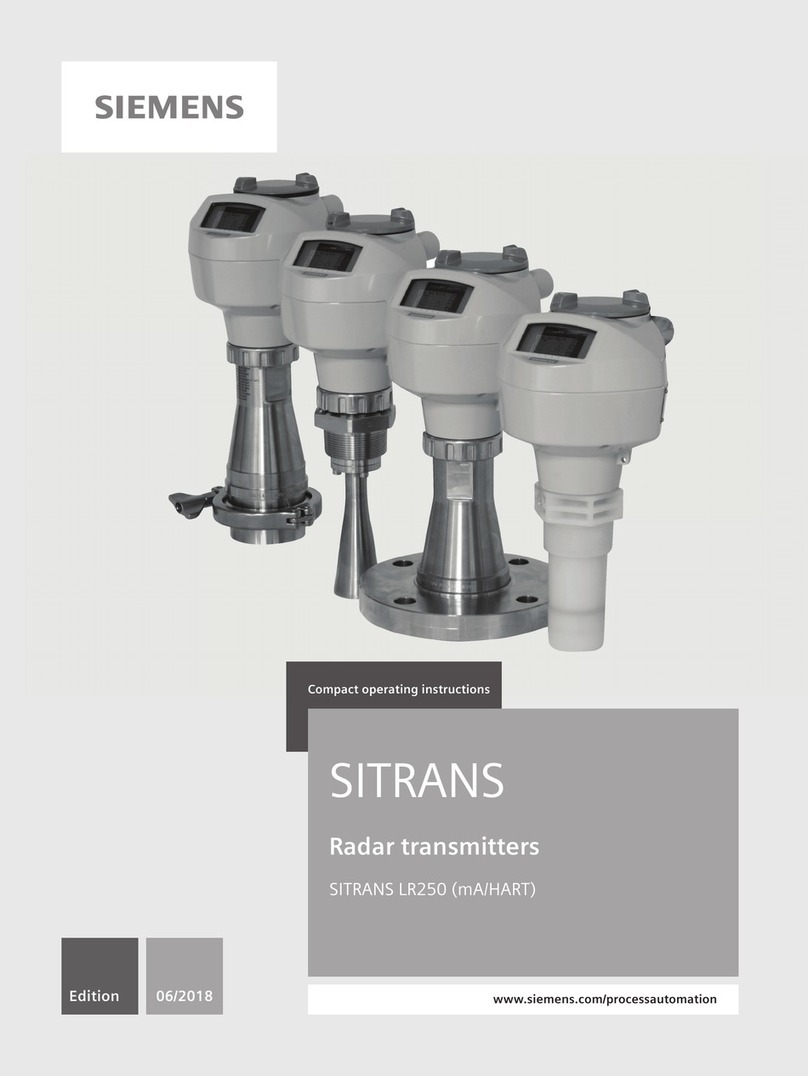
Siemens
Siemens Sitrans LR250 Compact operating instructions
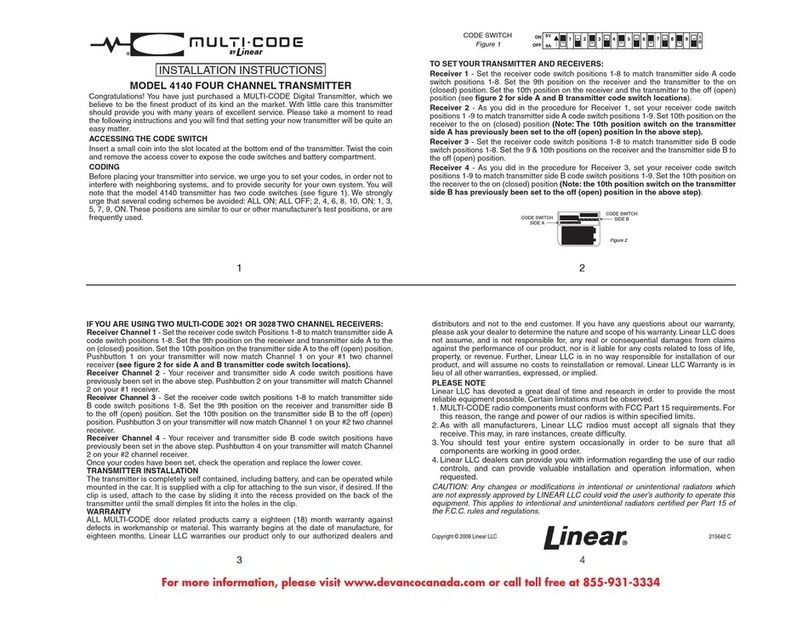
Multi-code
Multi-code 4140 installation instructions
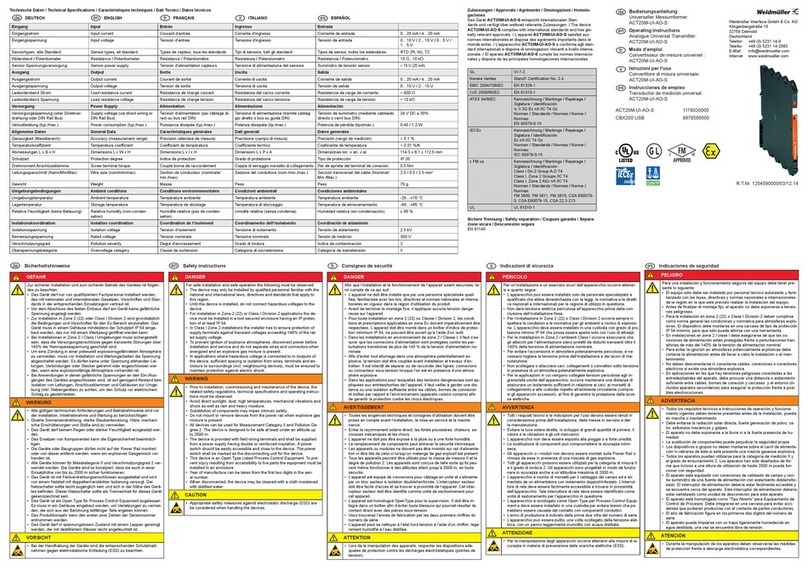
Weidmüller
Weidmüller ACT20M-UI-AO-S operating instructions
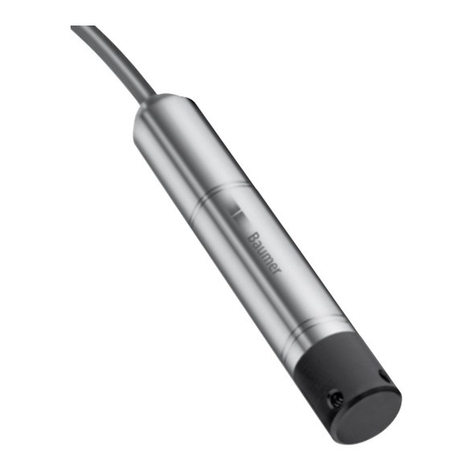
Baumer
Baumer PSMN Series Installation hints
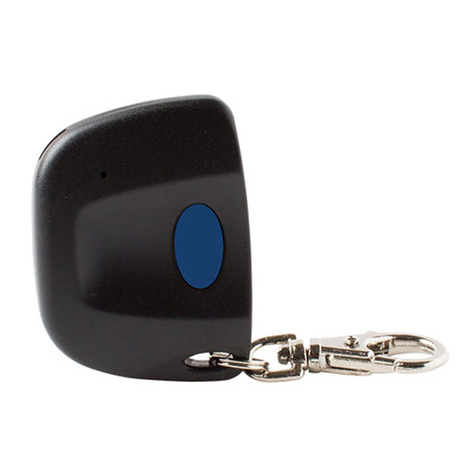
Transmitter Solutions
Transmitter Solutions Firefly3 manual
